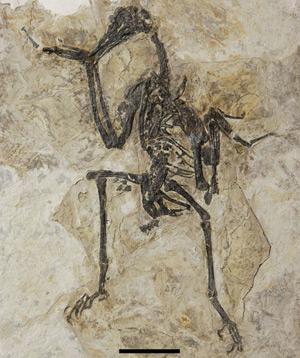
12:32 08 December 2009 by Colin Barras
Fad dieting wasn't an option in the Cretaceous, so the earliest birds went to more extreme measures to address weight issues: they lost their teeth.
 |
| Holotype of Zhongjianornis yangi gen. et sp. nov. (Image: ZHOU Zhonghe, ZHANG Fucheng and LI Zhiheng) |
Archaeopteryx, at 150 million years old still the oldest known bird, had an imposing set of teeth. But within 20 million years, at least some birds were toothless. Now a team led by ZHOU Zhonghe at the Chinese Academy of Sciences in Beijing believe they know why.
They discovered Zhongjianornis yangi, a toothless bird from 22 million years ago in China's Liaoning province. Their analysis shows that Z. yangi belonged to one of four bird groups that independently lost their teeth, implying that this loss was no evolutionary fluke. Z. yangi's group is the most primitive among them, suggesting it could provide clues as to why tooth loss occurred.
The team compared the body structure of a number of early birds and found that some toothed species were more adapted for flight. They think natural selection may have put pressure on weaker fliers to lose their teeth in a bid to improve their skills by losing excess weight. "It would be especially advantageous to reduce the weight of the head because [it] is further from the centre of gravity," they write.
That theory is "as good as any other", says Mike Benton at the University of Bristol, UK, though he remains sceptical. "Losing teeth wouldn't make a huge difference to balance in the air."
Journal reference: Proceedings of the Royal Society B, DOI: 10.1098/rspb.2009.0885

86-10-68597521 (day)
86-10-68597289 (night)

86-10-68511095 (day)
86-10-68512458 (night)

cas_en@cas.cn

52 Sanlihe Rd., Xicheng District,
Beijing, China (100864)

